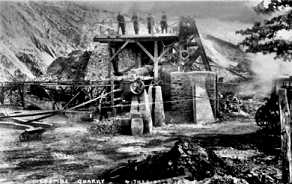

|
Hannaford's 1920 sale catalogue of Coombe property makes clear that the Quarry was "in the occupation" of Mr Nott on a lease for ten years from 29th September 1919. So 1920 is confirmed as the purchase date). The ropeway was in place and working when Fred Davey joined the firm in 1928, and it probably began about 1924. Fred Davey suggests there were probably 10 to 12 trestles. He recalls it was Mr R. M. Stone who, as County Surveyor, fell out with Archie Nott not only over the use of county roads around Coombe Quarry (so necessitating the ropeway) but also over Bill Welch, the Coombe Quarry foreman, whom Stone wanted sacked. Nott refused, and the County Surveyor boycotted Nott's business for sometime thereafter. Mr Davey believes not only because lorries had problems with Hare's Hill and Coombe Ball (and were probably forbidden to use Drayford Bridge) but because a decision was taken to set up a tar plant, and the main road was clearly more convenient for communications.
The Ropeway was about one mile in length, with trestles on concrete bases every hundred yards or so. A Shute at Coombe filled the buckets where there were screens and crushers. The Ropeway ceased working in about 1934, when the weighbridge and portable engine went to Scott's Holmingham Quarry at Cove. While it worked, road stone continued to be taken by lorry from Coombe, the depot only dealt with tarmac. It may have been because of the extra strain put on Newbridge Hill by the tarmac Lorries, that the village side of the hill was concreted in the early 1930's. The pulley wheels at the tops of the trestles had to be, they carried about 40ft of hose greased, and one day when Mr Rice was travelling along in one of the buckets carrying out this greasing his mates for a laugh stopped the endless rope and left him there for a time. (WP) Recalls that the ropeway was run by "a big Tangye engine" installed by Mr Frank Lawrence. An old man called George Ash lived in a caravan by the gate, and lit up each working morning to raise steam. The wire ropes were continuous and the buckets were clipped to them. The buckets had small wheels for running on rails at the quarry end where they were filled up without stopping and the shute operator had to be very quick. Not only did stone for the tar-plant went up, but also most of the road stone in the various grades. Up to 40 men were employed in the quarry at one time. Stone went to the making of Winkleigh and Chivenor airfields during the 1939-1945 war. Previous Last Edited 05/08/2006 Copyright © 2000-2006 Witheridge Unless otherwise indicated on the page in question, the photographic images reproduced on this site belong to the Witheridge Archives, and, as such may not be reproduced for commercial purposes without written permission. However, you are welcome to use any of the photographs belonging to the archive for personal and/or non-commercial use. Any material shown as not being owned by the archive may not be reproduced in any form without first receiving written permission from the owner of the material in question. |


